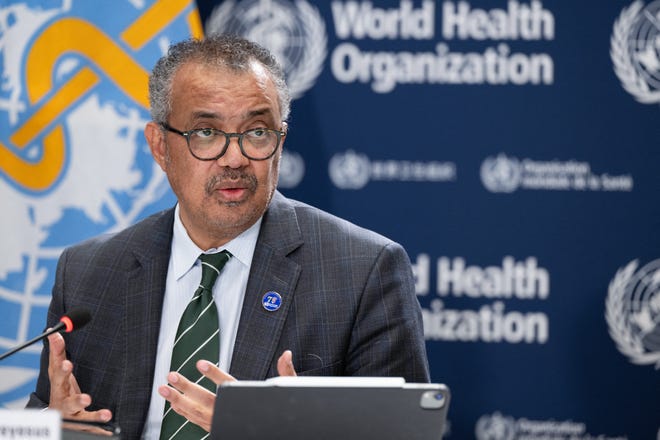What’s Illness X? WHO virus examine supplies roadmap to cease pandemic

A hypothetical virus dubbed Illness X has world leaders convening on the World Financial Discussion board in Switzerland this week to debate the way to stop the specter of one other cataclysmic pandemic.
Tedros Adhanom Ghebreyesus, director-general of the World Well being Group, deliberate to host a seminar Wednesday alongside different well being officers in Davos to arrange to confront the doubtless lethal virus.
The information ignited a heated debate on social media within the days main as much as the seminar, the place conspiracy theories proliferated, with some warning that potential measures may parallel the shutdown orders put in place through the Covid-19 pandemic.
However regardless of the resurging curiosity in Illness X, the theoretical pathogen isn’t a brand new subject for the WHO. Even earlier than the COVID-10 pandemic swept the globe, the United Nations company has spent years researching and making ready for the subsequent wave of lethal illnesses.
Right here’s what to find out about Illness X and the way world leaders are bracing for the subsequent pandemic.
What’s Illness X?
Illness X doesn’t exist – not less than, not but.
Fairly, the theoretical time period “represents the data {that a} critical worldwide epidemic might be brought on by a pathogen at the moment unknown to trigger human illness,” in response to the WHO. The “X” means “sudden,” however that does not imply leaders aren’t involved with making certain the world is prepared in case a lethal virus strikes.
In 2018, the company added the time period to its checklist of precedence illnesses and pathogens focused for analysis and growth. The plan, which incorporates identified killers like Extreme Acute Respiratory Syndrome (SARS) and Ebola, goals to “fast-track the provision of efficient exams, vaccines and medicines” that may save lives throughout a significant well being disaster, WHO stated.
How are world well being officers planning for the subsequent pandemic?
In 2022, WHO launched a worldwide scientific course of to replace the checklist of doubtless lethal pathogens that require funding in analysis to develop efficient vaccines, exams and coverings.
The method included scientific and public well being standards, but in addition made issues for the attainable socioeconomic impression and entry to life-saving measures.
The brand new strategy focuses on not simply particular person pathogens, but in addition on complete courses of viruses or micro organism. Greater than 200 scientists from 53 nations joined the trouble to independently consider 30 viral households, one core group of micro organism and the so-called “pathogen X,” which WHO fears has the power to set off one other extreme world pandemic.
To trace and handle rising virus threats, WHO and different well being consultants started boosting efforts to find and surveil lethal illnesses, ramped up analysis and bolstered scientific trials, in response to the company.
What menace does Illness X pose?
Illness X’s inclusion on the WHO precedence checklist implies that well being officers imagine there is a menace of an unknown (or long-forgotten) pathogen inflicting a critical worldwide epidemic sooner or later.
The WHO was prompted to create the blueprint years in the past after the Ebola outbreak in West Africa killed greater than 11,300 individuals between 2014 and 2016.
Alongside the governments of quite a few nations, in addition to each private and non-private scientific companies, WHO was in a position to create the “first-ever totally efficient vaccine in opposition to Ebola” that was examined inside a 12 months, Marie-Paule Kieny, a former WHO assistant director-general, beforehand stated.
Such measures are “important for a quick and efficient epidemic and pandemic response,” Michael Ryan, govt director of WHO’s Well being Emergencies Programme, stated in 2022, including that the preparedness is what allowed for COVID-19 vaccines to be developed “in report time.”
Eric Lagatta covers breaking and trending information for USA TODAY. Attain him at elagatta@gannett.com

